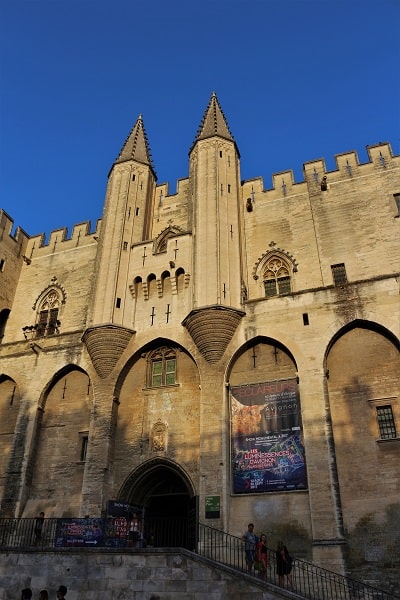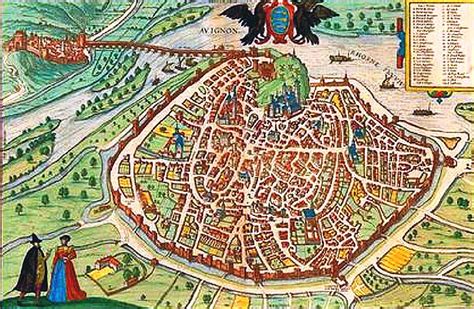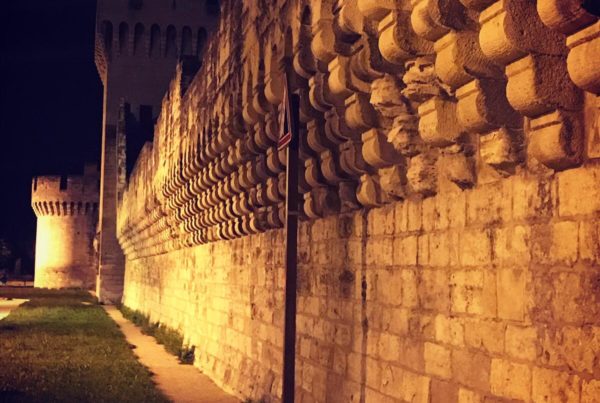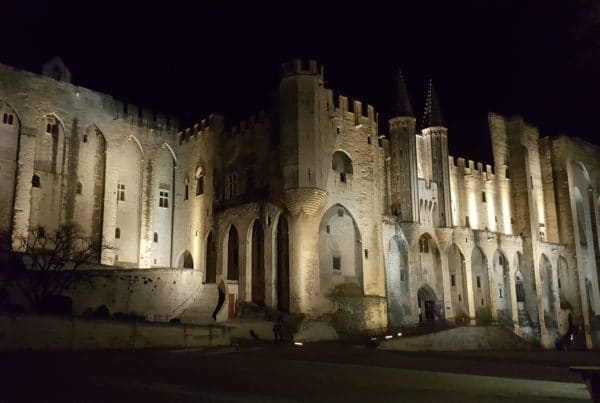then you arrive in Avignon, one of the first things you’ll see is the Palais des Papes (the Popes Palace). In addition to being the largest gothic palace in the world, it is also situated on a rocky spine. This gives it a unique stature. Despite this, its history or architecture remains a mystery to many visitors.
The Popes in Avignon
In the 14th century, Avignon became the capital of Christian Europe. Why did 7 Popes decide to settle in the city?
The city of Avignon before the Popes
Before the arrival of the Popes in Avignon, the city was already an important center of commerce and culture in Provence. It is located on the left bank of the Rhône. The Cavares, a Celto-Ligurian people, founded the city in the 5th century BC. The Romans became the masters of the city from the 2nd century. From the beginning, Avignon prospered as a commercial crossroads between the Mediterranean and northern Europe.
During the Middle Ages, Avignon was a fortified city, protected by ramparts and a castle. Several lords ruled the city. There was a large population of merchants, artisans and workers. The city was also an important cultural center, with a university founded in the 13th century and a rich tradition of Provençal poetry and music.
Why did the Popes leave Rome?
The Popes came to Avignon for political and security reasons. In the early 14th century, the Roman Catholic Church was in crisis.
The city of Rome was in the grip of many conflicts. From the 11th century on, the Popes decided to reside outside of Rome for the most part.
After the death of Pope Boniface VIII in 1304, the papacy was divided by a series of internal conflicts between different factions. In 1305, the French cardinal Bertrand de Got was elected pope as Clement V. This vote was made under pressure from Philip the Fair, the king of France.
Clement V wanted to return to Rome but due to the political instability of the city, he gave up this project. He decided to settle near his lands, the Comtat Venaissin, in 1309, in Avignon. This installation was intended to be temporary.
Popes who followed Clement V continued to reside in Avignon, eventually establishing their seat of Christendom in the city. It was considered safer and more conducive to stability than Rome, and they were also closer to the French court and its political influence.
History of the Popes Palace
Before the construction of the Popes Palace
The Palace of the Popes was built over two periods. It is Benedict XII who will begin the construction of the monument. He is the third Pope of Avignon.
Clement V was the first to settle in Avignon. He arrived in the city with his suite on March 9, 1309. The Pope will settle in the Dominican convent outside the city. He did not do any work on his residence, which he wanted to be temporary in the city.
His successor, John XXII, moved into the episcopal palace. He will transform it from the inside to make it compatible with his new function. From the outside, there will be no changes to make.
The construction of the Palace of the Popes
This biggest gothic palace in the world will be built by two popes, Benedict XII and Clement VI. The first will build the old palace. And the second will enlarge and enrich the building with the new palace.
The old palace
Benedict XII had several reasons to build the Old Palace. First of all, he sought to reinforce the authority of the pope in the region. Indeed, since two pontificates, the Popes had settled in Avignon. It was owner of ground in the east of the city, the Venaissin county,. Pope Benedict XII therefore wanted to have a larger and more prestigious place of residence to reinforce his power and prestige.
Moreover, the Old Palace offered a better protection against the political and military troubles which often broke out in the region at the time.
Finally, Benedict XII wished to leave a lasting mark of his time in Avignon by constructing a building that reflected the power and grandeur of the Catholic Church. The Old Palace thus became a symbol of papal power in Avignon.
The New Palace
Clement VI, whose real name was Peter Roger de Beaufort, was elected pope in 1342. He decided to build a new palace for several reasons.
First, the existing papal palace in Avignon had become too small to accommodate the papal court, which then numbered several hundred people, as well as the many visitors and ambassadors who came from all over Europe to meet with the pope.
In addition, the existing palace was considered obsolete and ill-suited to the needs of the papacy. Clement VI wanted a larger, more comfortable and modern palace that would reflect the power and grandeur of the Catholic Church.
Clement VI was a great patron of the arts and culture throughout his life. A larger palace allowed many artists such as Matteo Govanetti to be brought in. This allowed the emergence of the Avignon school, an artistic style unique to the city.
Thanks to his palace, Clement VI left his mark on the history of the city as well as on the history of the world.
The Popes Palace after the return to Rome
Gregory XI, the seventh pope of Avignon, decided to return to Rome. He left the city and his palace on September 13, 1376. Two years later, he died in Rome. He should have been the last pope of Avignon, but his succession will lead to the Great Western Schism. Two popes would succeed each other in Avignon during this turbulent period. The dispute for the throne of Saint Peter will end in 1415.
Avignon will lose the dynamism that characterized the city in the 14th century. The Palace of the Popes will become the palace of the vice-legates until the revolution.
When Avignon became French in 1791, the Palace of the Popes was already in an advanced state of decay. The revolutionaries would have wanted to destroy it completely. Fortunately, a general fell in love with the palace and proposed to transform it into a prison and military barracks. This saved the exterior structure of the palace but led to the destruction of its sumptuous interior.
The army left the palace at the beginning of the 20th century. It is now open to the public since 1906.
Gothic architecture at the service of papal power
The Popes Palace is the largest Gothic palace in the world.
On the main façade of the Old Palace, you can see it is decorated with a triple row of slender Gothic bays, which bring natural light into the interior spaces. The walls are reinforced by massive corner towers, with battlements and machicolations, which testify to the original defensive function of the palace.
The Palazzo Nuovo, built during the pontificate of Clement VI from 1342, is the most imposing part of the complex. It consists of several buildings arranged around a large courtyard of honor, lined with galleries topped by a magnificent Gothic rose. The main façade, facing the city, is decorated with a triple row of Gothic bays richly decorated with sculptures, pinnacles and gables. In the center of this facade are two defensive turrets that rise to a height of over 50 meters and dominate the city.
Inside the Palace of the Popes, the rooms are vast and richly decorated, with cross vaults, buttresses and slender columns. The papal apartments are particularly noteworthy, with their large fireplaces, frescoes and tapestries.
The Palace today
The Palace has always been important for the city. Yvonne Zervos will create a great art exhibition inside in 1947. Jean Vilar will participate to this cultural event by proposing two plays in the courtyard of honor. The Avignon festival was born. The courtyard of honor becomes each year, one of the most beautiful theaters in the world.
In 1995, the UNESCO will recognize the unique character of the Popes’ Palace and it will be classified as a world heritage site. This is the ultimate recognition for this building that changed the life of the city and Europe in the 14th century.
Since 2017, the visit of the palace is done with digital tablets, the histopad, in order to reconstruct the grandeur of the 14th century papacy. This allows visitors to fully immerse themselves in the atmosphere and uniqueness of the building.
Around the Palace of the Popes
The monument is central to the city and its history. It is possible to see the 2500 years of this history just by turning around the Palace of the Popes. This is what I suggest you discover in the tour Around the Palace. This tour is a nice introduction to the history of the city and the palace. It allows you to understand and appreciate even better the visit of the interior of the papal residence.






3 Comments